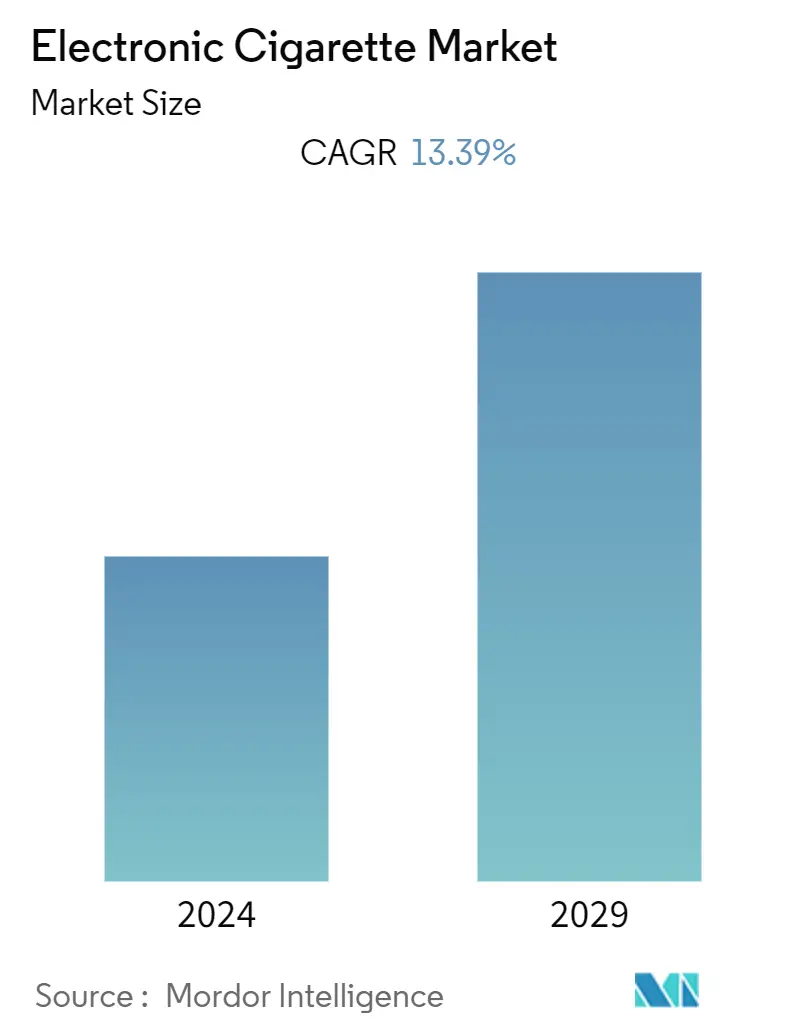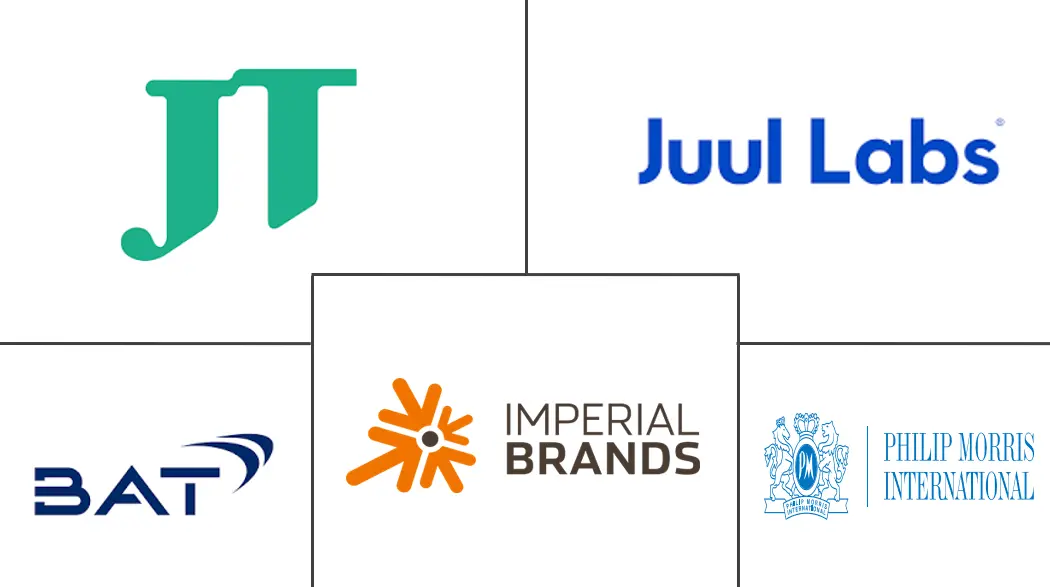Market Size of Electronic Cigarette Industry

| Study Period | 2019 - 2029 |
| Base Year For Estimation | 2023 |
| CAGR (2024 - 2029) | 13.39 % |
| Fastest Growing Market | North America |
| Largest Market | North America |
| Market Concentration | Low |
Major Players
*Disclaimer: Major Players sorted in no particular order |
Electronic Cigarette Market Analysis
The Electronic Cigarette Market is expected to register a CAGR of 13.39% during the forecast period.
As more people become aware of the harmful effects of traditional tobacco-based cigarettes, electronic cigarettes are gaining popularity, especially among young adults and adolescents. Electronic cigarettes have been recognized as an alternative to traditional cigarettes due to their several benefits, such as zero smoke, no pollution, reduced health-related problems, and the ability to smoke in public areas. Higher nicotine dependence, frequency of using e-cigarettes, poor online age verification, and several other factors are also boosting the demand for e-cigarette products.
Over the medium term, there was rising awareness regarding the health hazards associated with smoking. Rechargeable electronic cigarettes have also been well received by consumers, aided by their higher levels of flexibility compared to their single-use counterparts. As disposable electronic cigarettes offer cost-effective solutions to the new range of consumers looking to test electronic cigarettes, rechargeable electronic cigarettes heavily outweigh the cost difference in the long term.
The growth sales opportunity of electronic cigarettes through online channels made vendors improve their online purchase processes in terms of security and reliability, thus boosting the demand for these products online. With the growing popularity of vaping devices,s, flavor and fragrances vendors are introducing a wide variety of e-liquids to attract consumers. Different flavors, such as menthol, mint, chocolate, cola, bubble gum, and fusions of other fruits and flavoring substances are luring a large number of consumers to adopt these e-cigarette devices.
Electronic Cigarette Industry Segmentation
E-cigarettes usually include electronic circuitry and a power source supplying energy to the heating mechanism. They produce vapor by heating, which sets them apart from regular tobacco-based cigarettes that involve burning. Non-tobacco nicotine-containing liquid is most commonly used to produce vapor. The e-cigarette market is segmented by product type, category, distribution channel, and geography. By product type, the market is segmented into an e-cigarette device and E-liquid. By category, the market is segmented into open vaping systems and closed vaping systems (disposable devices). By distribution channel, the market is segmented into offline retail and online retail segments. By geography, the market is segmented into North America, Europe, and the rest of the world. The market sizing has been done in value terms in USD for all the abovementioned segments.
| Product Type | |
| E-cigarette Device | |
| E-liquid |
| Category | |
| Open Vaping System | |
| Closed Vaping System (Disposable Devices) |
| Distribution Channel | |
| Offline Retail | |
| Online Retail |
| Geography | |||||||||
| |||||||||
| |||||||||
|
Electronic Cigarette Market Size Summary
The electronic cigarette market is experiencing significant growth, driven by increasing awareness of the health risks associated with traditional tobacco products. As more individuals, particularly young adults and adolescents, seek alternatives to conventional cigarettes, e-cigarettes are gaining traction due to their perceived benefits, such as reduced health risks and the ability to use them in public spaces without the associated smoke and pollution. The market is further bolstered by the flexibility and cost-effectiveness of rechargeable and disposable e-cigarettes, which cater to a diverse consumer base. The rise of online sales channels has also contributed to market expansion, with vendors enhancing security and reliability to meet growing demand. The introduction of a wide variety of e-liquids, featuring diverse flavors, has attracted a broader audience, reinforcing the appeal of e-cigarettes as a healthier and more economical option compared to traditional smoking.
North America holds a dominant position in the electronic cigarette market, with a significant portion of the youth population adopting these products. The availability of numerous e-cigarette flavors and the perception of vaping as a fashionable activity have further fueled demand in the region. The market is characterized by intense competition among numerous local, domestic, and international players, with companies focusing on product innovation and technological advancements to capture consumer interest. Major industry players, including British American Tobacco PLC, JUUL Labs Inc., Imperial Brands PLC, Philip Morris International Inc., and Japan Tobacco Inc., are actively engaging in strategic initiatives, such as acquisitions and product launches, to strengthen their market presence. The competitive landscape is marked by a high concentration of firms and substantial advertising expenditures, underscoring the dynamic nature of the electronic cigarette market.
Electronic Cigarette Market Size - Table of Contents
-
1. MARKET DYNAMICS
-
1.1 Market Drivers
-
1.2 Market Restraints
-
1.3 Industry Attractiveness - Porter's Five Forces Analysis
-
1.3.1 Threat of New Entrants
-
1.3.2 Bargaining Power of Buyers/Consumers
-
1.3.3 Bargaining Power of Suppliers
-
1.3.4 Threat of Substitute Products
-
1.3.5 Intensity of Competitive Rivalry
-
-
-
2. MARKET SEGMENTATION
-
2.1 Product Type
-
2.1.1 E-cigarette Device
-
2.1.2 E-liquid
-
-
2.2 Category
-
2.2.1 Open Vaping System
-
2.2.2 Closed Vaping System (Disposable Devices)
-
-
2.3 Distribution Channel
-
2.3.1 Offline Retail
-
2.3.2 Online Retail
-
-
2.4 Geography
-
2.4.1 North America
-
2.4.1.1 United States
-
2.4.1.2 Canada
-
2.4.1.3 Rest of North America
-
-
2.4.2 Europe
-
2.4.2.1 United Kingdom
-
2.4.2.2 Germany
-
2.4.2.3 France
-
2.4.2.4 Spain
-
2.4.2.5 Italy
-
2.4.2.6 Russia
-
2.4.2.7 Rest of Europe
-
-
2.4.3 Rest of the World
-
2.4.3.1 Asia-Pacific
-
2.4.3.2 South America
-
2.4.3.3 Middle East & Africa
-
-
-
Electronic Cigarette Market Size FAQs
What is the current E-cigarette Market size?
The E-cigarette Market is projected to register a CAGR of 13.39% during the forecast period (2024-2029)
Who are the key players in E-cigarette Market?
Imperial Brands PLC, JUUL Labs Inc., British American Tobacco Inc., Philip Morris International Inc. and Japan Tobacco Inc. are the major companies operating in the E-cigarette Market.

